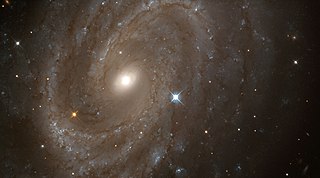
NGC 4603 is a spiral galaxy located about 107 million light years away in the constellation Centaurus. It is a member of the Centaurus Cluster of galaxies, belonging to the section designated "Cen30". The morphological classification is SA(s)c, which indicates it is a pure spiral galaxy with relatively loosely wound arms.

NGC 5614 is an unbarred spiral galaxy in the constellation Boötes. It is the primary member of the Arp 178 triplet of interacting galaxies with NGC 5613 and NGC 5615.
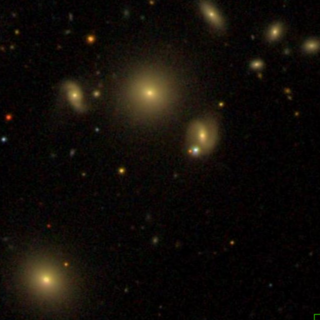
NGC 3554 is an elliptical galaxy in the constellation Ursa Major. It was discovered in December 1827 by John Herschel.

NGC 3271 is a barred lenticular galaxy in the constellation Antlia. At magnitude 11.7, it is the brightest galaxy in the Antlia Cluster, which lies about 40.7 megaparsecs away. It was discovered on May 1, 1834 by the astronomer John Herschel.

NGC 3267 is a lenticular galaxy in the constellation Antlia. It is a member of the Antlia Cluster, which lies about 40.7 megaparsecs away. It was discovered on April 18, 1835 by the astronomer John Herschel.

NGC 3258 is an elliptical galaxy in the constellation Antlia. It is a member of the Antlia Cluster, which lies about 40.7 megaparsecs away. It was discovered on May 2, 1834 by John Herschel.

NGC 3260 is an elliptical galaxy in the constellation Antlia. It is a member of the Antlia Cluster, which lies about 40.7 megaparsecs away. It was discovered on May 2, 1834 by the astronomer John Herschel.

NGC 3281 is a large unbarred spiral galaxy in the southern constellation of Antlia, located at a distance of 144.7 megalight-years from the Milky Way. The galaxy is inclined by an angle of 64° to the line-of-sight from the Earth, with the major axis aligned with a position angle of 137°. It is a luminous infrared galaxy and a type II Seyfert galaxy. NGC 3281 is a member of the Antlia Cluster, which belongs to the Hydra–Centaurus Supercluster.

NGC 1728 is a spiral galaxy in the constellation Eridanus. The galaxy is listed in the New General Catalogue. It was discovered on November 10, 1885 by the astronomer Edward Emerson Barnard.
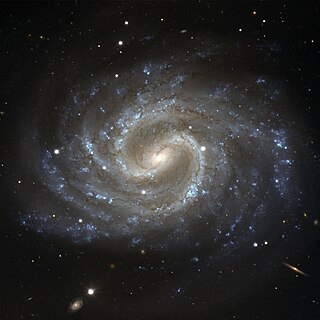
NGC 4535 is a barred spiral galaxy located some 54 million light years from Earth in the constellation Virgo. It is a member of the Virgo Cluster of galaxies and is located 4.3° from Messier 87. The galactic plane of NGC 4535 is inclined by an angle of 43° to the line of sight from the Earth. The morphological classification of NGC 4535 in the De Vaucouleurs system is SAB(s)c, which indicates a bar structure across the core (SAB), no ring (s), and loosely wound spiral arms (c). The inner part of the galaxy has two spiral arms, which branch into multiple arms further away. The small nucleus is of type HII, meaning the spectrum resembles that of an H II region.

NGC 159 is a barred lenticular galaxy in the constellation Phoenix. The galaxy was discovered on October 28, 1834, by John Frederick William Herschel.

NGC 3921 is an interacting galaxy in the northern constellation of Ursa Major. Estimates using redshift put it at about 59 million light years from Earth. It was discovered on 14 April 1789 by William Herschel, and was described as "pretty faint, small, round" by John Louis Emil Dreyer, the compiler of the New General Catalogue.

NGC 1683 is a spiral galaxy in the constellation Orion. The object was discovered in 1850 by the Irish astronomer William Parsons.

NGC 1326 is a lenticular galaxy in the constellation Fornax, 63 million light-years away. It was discovered by English astronomer John Herschel on 29 November 1837. It is a member of the Fornax Cluster, an NGC 1316 subgroup and has a diameter of 70 000 light-years.
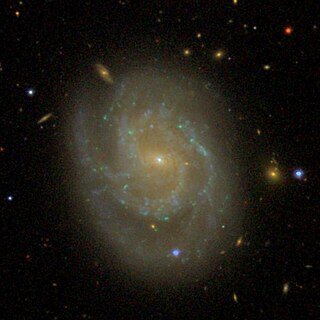
NGC 3686 is a spiral galaxy that forms with three other spiral galaxies, NGCs 3681, 3684, and 3691, a quartet of galaxies in the Leo constellation. It was discovered on 14 March 1784 by William Herschel. It is a member of the NGC 3607 Group of galaxies, which is a member of the Leo II Groups, a series of galaxies and galaxy clusters strung out from the right edge of the Virgo Supercluster.
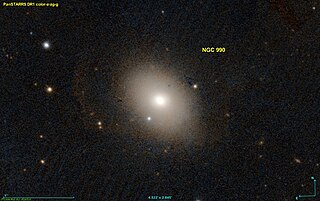
NGC 990 is an elliptical galaxy located in the constellation Aries about 153 million light-years from the Milky Way. It was discovered by the German - British astronomer William Herschel in 1786.

NGC 906 is a barred spiral galaxy in the constellation Andromeda in the northern sky. It is estimated to be 215 million light years from the Milky Way and has a diameter of approximately 110,000 ly. NGC 906 was discovered on October 30, 1878 by astronomer Édouard Stephan.

NGC 531 is a barred spiral galaxy in the constellation Andromeda with a visual magnitude of 10.51. It is a distance of 65.7 Mpc from the Sun. It is a member of the Hickson Compact Group HCG 10, and is interacting with the other members of the group.

NGC 861 is a spiral galaxy in the constellation Triangulum. It is estimated to be 360 million light-years from the Milky Way and has a diameter of approximately 165,000 light-years. The object was discovered on September 18, 1865 by Heinrich d'Arrest.

NGC 677 is an elliptical galaxy located in the constellation Aries. It was discovered on September 25, 1886, by the astronomer Lewis A. Swift. It is located about 200 million light-years from Earth at the center of a rich galaxy cluster. It has a LINER nucleus.




















